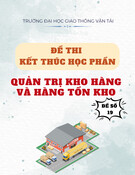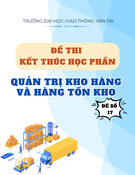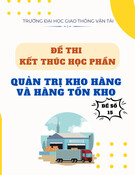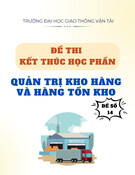
* Corresponding author
E-mail address: paveeratpp@gmail.com (P. Pakdeenarong)
© 2020 by the authors; licensee Growing Science.
doi: 10.5267/j.uscm.2019.7.007
Uncertain Supply Chain Management 8 (2020) 165–174
Contents lists available at GrowingScience
Uncertain Supply Chain Management
homepage:
www.GrowingScience.com/uscm
Supply chain risk management of organic rice in Thailand
Paveerat Pakdeenaronga* and Thammanoon Hengsadeekula
aSchool of Logistics and Supply Chain, Naresuan University, 99 Moo 9 Tambon Tha Pho, Muang Phitsanulok 65000, Thailand
C H R O N I C L E A B S T R A C T
Article history:
Received June 17, 2019
Received in revised format June
28, 2019
Accepted July 17 2019
Available online
July 1
7
2019
This study aims to identify and mitigate supply chain risks associated with organic rice in
Thailand, based on the principle of supply chain risk management (SCRM). The risk
measurement is performed using Best-Worst method (BWM) for ranking the criticality of
different factors in order to find the appropriate ways for improving and developing new ideas
for supply risk chain management. The study identifies 26 risk factors associated with the
organic rice supply chain based on the literature and interviews with four experts. The order of
risk priority in the organic rice supply chain in descending order (the top 5) is as follows: Lack
of efficient equipment or machinery, Lack of organic rice mill, Lack of labor, Transportation
cost, and Production cost. The SCRM guidelines of organic rice in Thailand include cost
reduction and investment in infrastructure.
.
by the authors; licensee Growing Science, Canada
20
20
©
Keywords:
Supply chain risk management
Supply chain risk
Risk analysis
Organic rice
1. Introduction
The trend of a healthy and natural environment is growing in popularity. Consumers and manufactures
all over the world have become increasingly aware of health and food safety, and are conscious about
preserving the environment. In effect, organic goods are getting increased attention and consumers’
demand for organic products is rising both domestically as well as internationally. One such preferred
commodity is organic rice, which is certified by an independent body that sets the standards for organic
farming. Rice is a major economic crop; Thailand’s geographic location and farming policy enhances
its potential for producing organic rice, which is primarily undertaken by smallholders, farmers’ groups,
or large agro-enterprises. Unfortunately, organic rice farming generates a lower output compared with
regular rice farming. However, Thailand has a huge potential for organic production. There are several
risks in the supply chain. Agricultural products have specific characteristics, such as seasonality and
perishability, that make risk management for agricultural supply chain more complex. An agricultural
supply chain encompasses all components of a process which includes various stages related to
sourcing, producing, post-harvesting, storing, processing, and delivering. Therefore, it is important to
study the supply chain risk management (SCRM) of organic rice in Thailand in order to manage and
mitigate risk properly, effectively and sustainably.

166
2. Review of Literature
2.1 Supply Chain Risk
Globalization has hugely impacted industrial manufacturing thereby increasing the pressure to improve
quality, flexibility, and efficiency while maintaining costs. Due to this, supply chain risk is cited as the
most important reason for under performance. There are many definitions of risk. Risk in general is
described as uncertainty, negative, unpredictable, and an uncontrollable outcome (Aqlan & Lam, 2016;
The Committee of Sponsoring Organizations of the Treadway Commission, 2004). From a supply chain
perspective, risk is associated with the negative consequences of uncertainty within the supply chain or
network (Christopher & Lee, 2004; Wagner & Bode, 2006). Another classification provided by Tang
(2006) linked supply chain risk to the uncertainty of occurrence of an event that could affect one (or
more) partner(s) or link within the supply chain and that could negatively influence the achievement of
the company's business objectives and identified risks in material (source, make, deliver), information,
and financial flows. Tang and Musa (2011) suggested that supply chain risks should refer to (i) events
with a lower probability but could occur unexpectedly and (ii) events that bring substantial negative
consequences to the system. In the agriculture supply chain; problems, risks and vulnerabilities have
been discussed in various contexts such as yield, cost, and price variability for different agricultural
products (Behzadi et al., 2018). Similarly, Schmitt and Snyder (2012) classified them into five forms:
disruptions, lead time uncertainty, yield uncertainty, capacity uncertainty, and input cost parameter
uncertainty. Yeboah et al. (2014) divided them into eight parts: (1) Weather/ Natural Disasters Risk (2)
Biological and Environmental Risk (3) Market Risk (4) Logistical and Infrastructure Risk (5) Political
Risk (6) Policy and Institutional Risk (7) Financial Risk (8) Operational and Managerial Risks. Tang
and Tomlin (2008) explained that risk mitigation strategies are implemented in order to reduce the
likelihood of occurrence and/or negative impact of risks. Hence, risk is an inherent part of the supply
chain.
2.2 Supply Chain Management
There are various definitions of supply chain management (SCM). Mentzer et al. (2004) define supply
chain as a network of suppliers who provide raw materials, parts, components, assemblies, sub-
assemblies, and final products together with processes and customers. Typically, a supply chain process
consists of manufacturing raw products and materials at factories, transporting to warehouses for
storage, and delivering to customers. Chopra and Meindl (2007) explained that SCM includes different
approaches and effectively integrates suppliers, manufacturers, distributors, and customers to enhance
the long-term performance of individual companies and the whole supply chain in a comprehensive,
high performance business model. Cao and Zhang (2011) found that SCM involves the design and
management of all procurement and activities as well as the coordination and collaboration with
existing network partners. In other words, SCM is the management of the flow of goods and services
and includes all processes that transform raw materials into final products. Thus, SCM has become
more important in the industrial world which supply and deliver products to the final customers.
2.3 Supply Chain Risk Management
Supply chain risk management (SCRM) is becoming an important and widely-researched subject and
has many definitions. Wieland and Wallenburg (2012) define SCRM as the implementation of
strategies to manage risks along the supply chain based on continuous risk assessment with the
objective of reducing vulnerability and ensuring continuity. Manuj and Mentzer (2008) define SCRM
as the identification and evaluation of risks and subsequent losses in the supply chain, and
implementation of appropriate strategies through a coordinated approach by the supply chain members.
Tang and Musa (2011) emphasize that supply chain risk is managed through coordination or
collaboration among the supply chain partners to ensure profitability and continuity. In other words,
SCRM is the process of applying risk management tools, together with partners in a supply chain, to
address risks and uncertainties caused by, or affecting, logistics related activities or resources in the

P. Pakdeenarong and T. Hengsadeekul /Uncertain Supply Chain Management 8 (2020)
167
supply chain (Brindley, 2004). Wieland and Wallenburg (2012) showed that SCRM attempts to reduce
supply chain vulnerability via a coordinated holistic approach, involving all supply chain members,
which identify and analyze the risk of failure points within the supply chain. This definition was given
by the Supply Chain Council research team (SCC) in 2008. SCRM is aimed at managing risks of four
processes: identification, assessment, controlling, and monitoring of supply chain risks (Wieland and
Wallenburg, 2011). Giannakis and Papadopoulos (2016) proposed a risk management process to
identify and manage sustainability related risks demonstrated its application through empirical case
studies and a survey questionnaire. Consequently, most of the manufacturers show an increasing
concern about their supply chain management.
3. Method
3.1 The ORSC Risks
This section discusses the ORSC risks that may occur. There are many risks exist in each phase of
ORSC. Hence, in this study, the interview was used to identify the risk factors of ORSC. After an
interview with the decision team, the main risk factors were extracted and were shown in Table 1. This
study was executed in Thailand. The decision team includes four expert of organic rice industry.
Table 1
List of ORSC Risks
No.
Risk factors
Risk sub factors
1. Source risks Cost of materials (S1), Lack of raw materials (S2), Unsuitable cultivated area (S3),
Damage or loss quality (S4), Few suppliers (S5)
2. Make
(Production) risks
Production cost (MP1), Damage during production (MP2), Lack of labor (MP3),
Water storage (MP4), Lack of efficient equipment or machinery (MP5), Natural
disasters (MP6)
3. Make (Mill) risks Process cost (MM1), Damage during process (MM2), Lack of organic rice mill
(MM3), Low capacity utilization (MM4), Low quality of rice milling machine
(MM5)
4. Deliver risks Transportation cost (D1), Damage during delivery (D2), Transportation failure
(D3), Infrastructure failure (D4), Incompatible transportation procedure (D5)
5. Storage risks
Cost of inventory (ST1), Damage during storage (ST2), Lack of storage (ST3),
Inappropriate storage method (ST4), Improper packaging (ST5)
3.2 Best Worst method (BWM)
BMW is a comparison-oriented MCDM method that compares the best criterion to other criteria and
all the other criteria to the worst criterion. The goal is to find the optimal weights and consistency ratio
through a simple linear optimization model constructed by the comparison system (Rezaei et al., 2016;
Ghaffari et al., 2017).
Below is a description of the steps of BWM to calculate the weight of the criteria (Rezaei et al., 2016)
1) Determine the set of decision criteria {𝑐, 𝑐, … , 𝑐} by decision-makers.
2) Determine the best and the worst criteria to be used for the decision environment: In this step,
decision-makers choose the best and the worst criteria among the set of criteria identified in Step 1
from their perspective. The best criterion represents the most important criterion and the worst criterion
is the least important criterion for the decision.
3) Determine the preference of the best criterion compared with all the other criteria: A number between
1 and 9 (1: equally important, 9: extremely more important) is used to indicate this value. The resulting
Best-to-Others vector would be as AB = (𝑎, 𝑎, … , 𝑎). Where 𝑎 indicates the preference of
criteria B (best criteria) over criteria j and 𝑎= 1

168
4) Determine the preference of each of the other criteria over the worst criteria: A number between 1
and 9 is assigned to this case as well. The Others-to-Worst vector would be as AW = ( 𝑎, 𝑎, …
, 𝑎)T, where, 𝑎 indicates the preference of the criterion j over the worst criteria W and 𝑎 = 1
5) Find the optimal weights (𝑤
∗, 𝑤
∗, … , 𝑤
∗): Solve problem (1) to receive the optimal weights for the
criteria. To determine the optimal weights of the criteria, the maximum absolute differences {|𝑤 –
𝑎𝑤|, |𝑤 – 𝑎𝑤|} for all j should be minimized.
This model can be solved by transferring it to the linear programming (2) (Rezaei, 2015) as follows,
𝑚𝑖𝑛
𝑚𝑎
𝑥
−
𝑎
,
−
𝑎
subject to
𝑤
=
1
(1)
𝑤
≥
0
,
𝑓𝑜𝑟
𝑎𝑙𝑙
𝑗
or
min ξ
subject to
𝑤
−
𝑎
𝑤
≤
ξ
,
for
all
j
𝑤
−
𝑎
𝑤
≤
ξ
,
for
all
j
(2)
𝑤
=
1
𝑤
≥
0
,
𝑓𝑜𝑟
𝑎𝑙𝑙
𝑗
By solving this problem, the optimal weights (𝑤
∗, 𝑤
∗, … , 𝑤
∗) and the optimal value of ξ *are obtained.
ξ * Is defined as the consistency ratio of the comparison system. It means that the closer ξ* is to zero the
more consistent the comparison system is provided by the decision maker. Eq. (3) can be used to check
the consistency of the comparisons (Rezaei et al., 2017).
𝐶𝑜𝑛𝑠𝑖𝑠𝑡𝑒𝑛𝑐𝑦
𝑅𝑎𝑡𝑖𝑜
=
∗
(3)
Table 2
Consistency index (CI) table
𝑎
1
2
3
4
5
6
7
8
9
Consistency index
0.00
0.44
1.00
1.63
2.30
3.00
3.73
4.47
5.23
Table 2 shows the maximum values of ξ (consistency index) for different values of 𝑎.
4. Results
At this step, BMW which was explained earlier is utilized to obtain the importance weights of ORSC
Risks.

P. Pakdeenarong and T. Hengsadeekul /Uncertain Supply Chain Management 8 (2020)
169
4.1 Determination of the Criteria Set
The criteria set is determined on the basis of the extensive literature review and interview with experts
as shown in the Table 1
4.2 Determination of the Best and the Worst Criteria
The second step in the BWM is the determination of the best and the worst criteria. The best criterion
is the one selected by each respondent as the most important ORSC risks, while the worst criterion is
the one which is the least important ORSC risks based on the opinion of each expert. Experts of this
research selected Lack of efficient equipment or machinery (MP5) as the best criterion and Damage or
loss quality (S4) as the worst criterion, respectively.
4.3 Determination of the preference of the Best Criterion over all the Others
This step consists of identifying the preferences of the best criterion from over all the other criteria.
These data are gained by using BWM special questionnaire. The experts are asked to compare their
selected best criterion with each of the other criteria and state their preference by using a value between
1 and 9. A score of 1 implies an equal importance over the other criteria. A score of 9 implies that the
most important criterion is extremely more preferred with respect to the other criteria. Then, by
calculating arithmetic mean of the four expert's questionnaires, an average weight is determined.
4.4 Determination of the Preference of all Criteria over the Worst Criterion
This step is similar to the previous step, but in this step, the experts are asked to state their preferences
of all other criteria over the least important criterion. Similar to the previous step, a value between 1
and 9 is used. Then, by calculating Arithmetic mean of 4 expert's questionnaires, an average weight is
determined.
4.5 Determination of the ORSC Risks Weights
The weights of ORSC Risks are calculated with a linear model (2) of BWM. By solving this linear
model, optimized values of ORSC Risks weights and ξ * can be obtained.
Table 3
Best-to-others (BO) and others-to-worst (OW) pairwise comparison vectors for ORSC Risks
BO
Source
Make (Product
ion)
Make (Mill)
Deliver
Storage
Best criterion: Make
7
1
2
3
5
OW
Worst criterion: Source
Source
1
Make (Production)
7
Make (Mill)
6
Deliver
5
Storage
3
Table 4
ORSC Risks Weight
Criteria
Weight
Rank
Source
0.050
5
Make (Production)
0.427
1
Make (Mill)
0.253
2
Deliver
0.169
3
Storage
0.101
4
ξ
*
0.079
Consistency Ratio
0.035

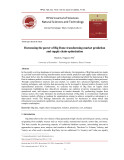


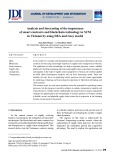
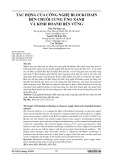


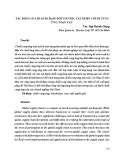

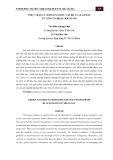
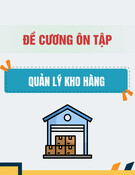

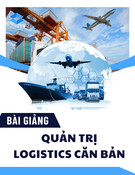
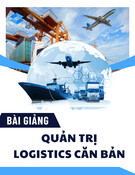
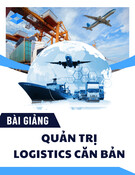
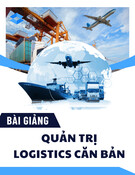

![Đề kiểm tra Quản trị logistics [mới nhất]](https://cdn.tailieu.vn/images/document/thumbnail/2025/20251015/2221002303@sv.ufm.edu.vn/135x160/35151760580355.jpg)
![Bộ câu hỏi thi vấn đáp Quản trị Logistics [năm hiện tại]](https://cdn.tailieu.vn/images/document/thumbnail/2025/20251014/baopn2005@gmail.com/135x160/40361760495274.jpg)
